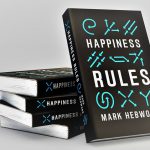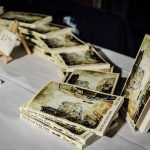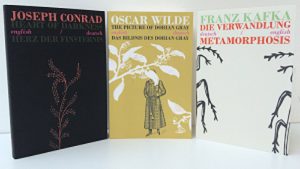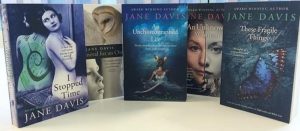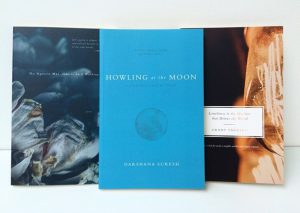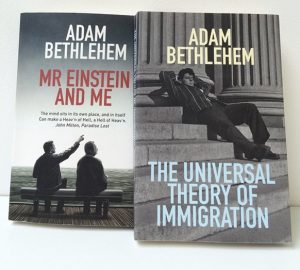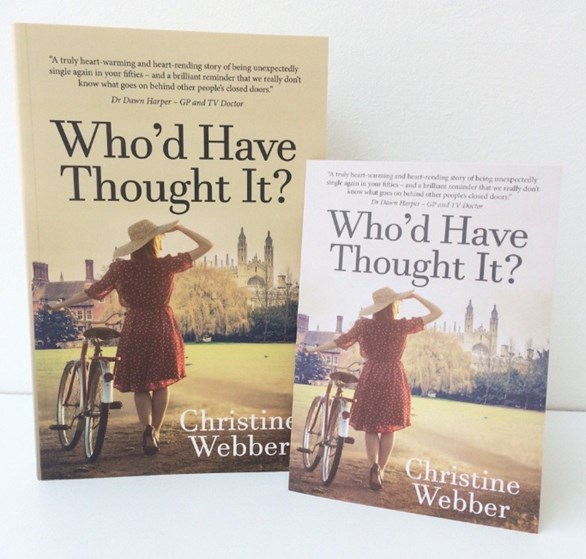
We met the lovely Christine Webber back at our Indie Insights event on February 4th 2016, and learnt about her new novel Who’d Have Thought It? – having been traditionally published with her non-fiction titles, Christine made the leap to becoming a “hybrid” author, publishing her novel independently! She very kindly answered our many questions on her indie publishing experience …
As a ‘hybrid’ author whose non-fiction work is traditionally published you have experienced the benefits of both publishing routes. What, to you, are the benefits of publishing your own work independently?
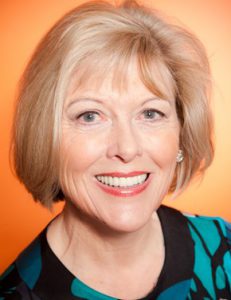 The main benefit is how speedily one can get a book into the market place and see it in print. I was thinking about Indie publishing – but had done nothing about it – at the beginning of 2016. On a whim, I attended a workshop, run by Clays, on February 4th. This made up my mind to go for it, and my novel came out on June 10th! The other huge benefit is the control you have. I love Who’d Have Thought It? more than any other book I’ve written, and I’m sure this is because I’ve made all the decisions about it myself, and feel that it is truly mine. This might sound slightly pathetic, but I just love looking at, and touching, the finished product!
The main benefit is how speedily one can get a book into the market place and see it in print. I was thinking about Indie publishing – but had done nothing about it – at the beginning of 2016. On a whim, I attended a workshop, run by Clays, on February 4th. This made up my mind to go for it, and my novel came out on June 10th! The other huge benefit is the control you have. I love Who’d Have Thought It? more than any other book I’ve written, and I’m sure this is because I’ve made all the decisions about it myself, and feel that it is truly mine. This might sound slightly pathetic, but I just love looking at, and touching, the finished product!
What was behind your decision to go down the indie publishing route for your novel?
Although I had written a novel before, it was 29 years ago! In the meantime, I had penned more than a dozen self-help and other non-fiction books. All the publishing people I’d worked for therefore – who include Piatkus, Hodder and Quercus – were in that area. I did contact one or two fiction editors, and indeed agents, but this was taking up a huge amount of time – and it was time I didn’t feel I wanted to waste. Meanwhile, I had friends and colleagues who, like me, had been conventionally published for years but who had ventured into indie publishing. I was inspired and influenced by them.
Why did you decide you wanted your book in print?
I believed in this manuscript and very much wanted it to be a paperback. For a start, the story is about mid-life people and I think readers of that age – of whom I am one – have a preference for the feel and smell of a real, physical product. Having said that, I wouldn’t be without my Kindle and never get on a train without it. But, like many readers, I feel there’s nothing like the thrill of being in a lovely book store, and I very much want to support the people who run them. I also wanted 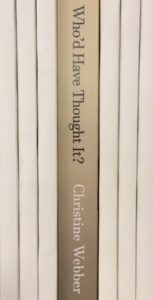 to produce a delightful book that someone might buy for a friend.
to produce a delightful book that someone might buy for a friend.
There are many indie print services, what made you choose Clays?
I have been familiar with Clays for more than 30 years. When I was a news presenter for Anglia Television, they were a major firm in our patch. And at one time, I lived very near their factory. Also, many of my published books were printed by them – notably my Hodder self-help books. But it would not have occurred to me that such a traditional firm might have ventured into indie publishing – I learned that they had through the wonderful organisation, the Alliance of Independent Authors (Alli). I found all my experts through their website, and was overjoyed to see the name of Clays listed under ‘printing’. It just felt right to go with them and I could not be more pleased with the result.
You also have an e-book. Why do you think it is important to have both e and p, and how do you think they work in collaboration?
I just think that it’s essential to offer both formats, though as yet I’m not sure which will be more successful for me.
As an indie author, you are responsible for the entire manuscript to market process, how did you navigate this?
I mentioned Alli in an earlier answer; I could not have coped without them. At every step of the way, I sought support and ideas from other members of the group and I used the Alli website to find everyone I needed to help make this product a reality. Also, both Georgina Aldridge and Rebecca Souster at Clays have been marvellous. I am sure they must have been fed up with all my queries, but they never showed it. Amazing!
You used professionals throughout the publishing process such as proof reading, cover design and typesetting. How much do you think using professionals enhanced the final product?
It would be madness to do this without professionals. Having said that, I know indie authors who are total whizz kids at technology, who do their own formatting and know how to put their own book online. I am in awe of them and their skill – but I don’t have it. If I had to learn how to do all that stuff as well, I’d never find time for writing.
The crucial expert, I think, is a good editor and proof reader. I found an absolute marvel in the shape of Helen Baggott (through Alli, naturally). I paid for three reads with her. That was money very well spent. Like many writers, I have always prided myself on producing clean manuscripts, but Helen picked up little mistakes that I had failed to notice. In an ideal world, I’d persuade her to live with me so that I could run queries past her morning, noon and night! Her knowledge is phenomenal. I was so fortunate to find her.
After my work with Helen, I moved on to the typesetting process with a company called BORN. They were wonderful to deal with. So helpful, and efficient – and I really want to pay particular tribute to Daniel Knight who worked on my book. He could not have been more patient.
As for the jacket, as we all know – and contrary to the old saying – we do judge a book by its cover. And I found a wonderful designer in Jane Dixon-Smith (another Alli member). She too was very sympathetic and tolerant. It took a while to arrive at exactly what I wanted, but she helped me get there, and everything I asked of her, she did. I loved working with her. I adore my cover. And I will definitely use her again, if she can bear it!
What impact has using professional services had on your indie publishing experience?
I was determined that Who’d Have Thought It? would look as professional as any traditionally published novel. I believe I have achieved that, which makes me very happy indeed.
One area you didn’t need any help was in publicity, creating a fantastic schedule of radio and TV interviews, blog appearances and magazine articles. How important do you think creating your own publicity is as an author?
It is vital – but not easy! I mentioned the skills of different authors earlier on. Unlike many of them I’m no expert in the technological areas, but promotion is 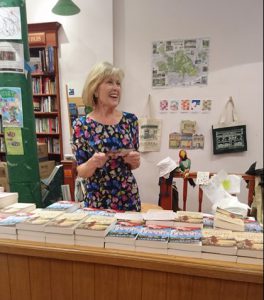 something I’m quite good at. This is partly because I’ve worked in theatre, television and journalism – and basically if you are to survive and thrive in any of those careers you have to be able to sell yourself, in the nicest possible way! Also, I do know a lot of broadcasters, and almost all of the ones I contacted were keen to interview me about the new book. My novel is set in East Anglia so I have enjoyed most of my publicity there. I had two TV interviews – one of which was at my old station, Anglia TV – and some good print journalism and extensive radio feature slots.
something I’m quite good at. This is partly because I’ve worked in theatre, television and journalism – and basically if you are to survive and thrive in any of those careers you have to be able to sell yourself, in the nicest possible way! Also, I do know a lot of broadcasters, and almost all of the ones I contacted were keen to interview me about the new book. My novel is set in East Anglia so I have enjoyed most of my publicity there. I had two TV interviews – one of which was at my old station, Anglia TV – and some good print journalism and extensive radio feature slots.
I also had a brief mention in The Guardian when I agreed, with my psychotherapist hat on, to do some quotes for a journo. And so, I suppose you could say I have maximised my contacts. On top of that, several indie authors, including Jane Davis, Carol Cooper, Victoria Goldman and Maggie Christensen, very kindly featured me in blogs. The indie community is very supportive, but of course you need to be supportive in return. Also, Bel Mooney – who has often recommended my self-help books – wrote a really lovely post on her Facebook Writing Page about the novel. I was thrilled with that.
In a nutshell, if you don’t tell people about your book, you’ll be unlikely to sell it. It’s as simple and as difficult as that. But it can be time-consuming and expensive. However, what authors should remember is that local press and radio stations need to fill their pages and websites and schedules with interesting material. And you may well be able to provide that. So always ask. You might get lucky! Also, you must be active on social media. I don’t have huge numbers of followers on Twitter, or masses of friends on Facebook, and plenty of people reading this could probably teach me a thing or two, but I find what I do have works quite well.
What would be your one stand out piece of advice from your indie publishing experience to others embarking on the same journey?
Make your book as good as it can be, then use all the experts you can afford to make it even better.
Click to follow Christine Webber on Twitter, or find her at http://www.christinewebber.com/.
